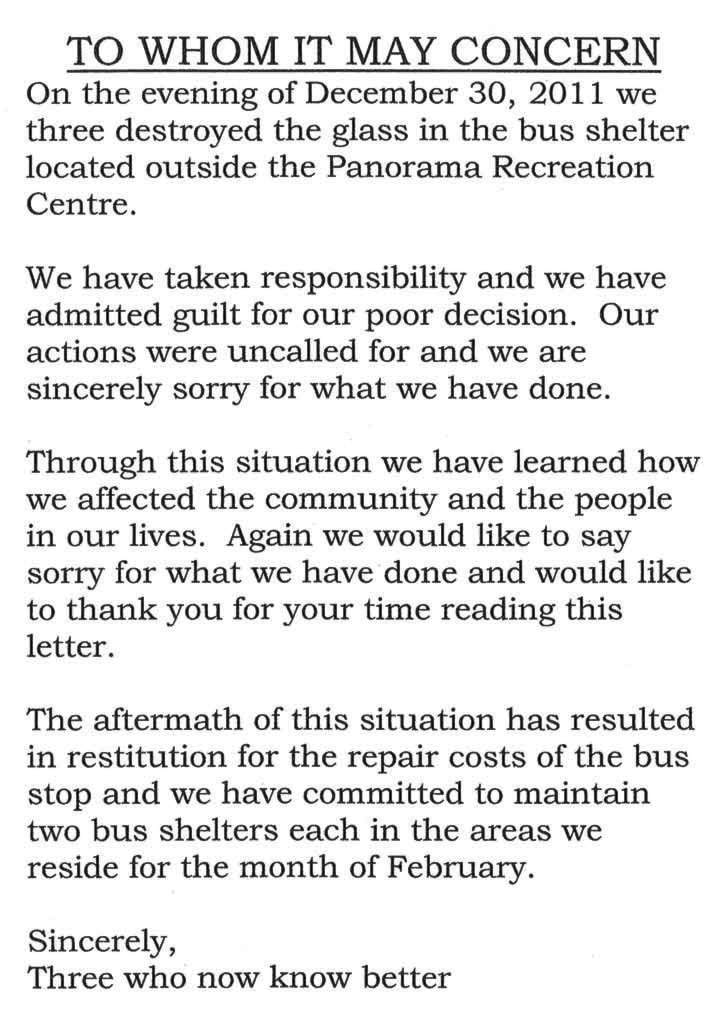For days, pebbles of glass greeted Leah Errington at her bus stop near Panorama Recreation Centre.
It wasn’t the best way to start the new year, with smashed panels of glass sparkling in broken bits and the bench was upside down and backwards.
Little did the Central Saanich woman know she would be an integral part of repairing the damage, not to the bus stop, but to the trust that shattered on Dec. 30 along with the glass.
That night, a trio of 17- and 18-year-olds were out partying. They created chaos at the bus stop, but were caught by police and admitted guilt that night. The admission is one part of the equation that made the Sidney North Saanich RCMP constable who caught them feel restorative justice might be in order. Their age and the fact that there was no history of previous dealings with police added to that belief.
“Up to a year and a half ago all referrals were from local police,” said Allan Collier of Peninsula Crossroads Community Justice Program. “They give us the cases that they feel are appropriate.”
Eighteen months ago the agency signed an agreement with Crown counsel which can now divert cases to the volunteer-based restorative justice program.
“We’re starting to get more and more Crown cases which are a little more complicated, a little more serious,” Collier said.
With more than 30 trained facilitators, the restorative justice program that started on the Peninsula in 1999 sees about 18 to 24 cases a year.
“It needs the agreement of the victim and the offender, or in our terms, the one who does harm and the one who has had harm done,” Collier said.
Affected parties are gathered for a circle, often in a space provided by Beacon Community Services, the parent organization for Peninsula Crossroads. In this case, Errington was there as a community representative.
“I got an opportunity to say how it had affected me, because I’m at that bus stop quiet frequently,” Errington said.
The teens, their families, the police officer, Errington and the bus stop owner all had a say in the circle. There, Errington got some insight to the shattered trust that went along with the vandalism that night.
“It really affected their families and that the respect from the family had really taken a dive,” she said.
In that meeting, the focus is to repair the damage done, Collier explained.
“You do it in a way that there is no blame, no shame, no fault. It’s ‘let’s find out how we can make it right,’” he said. “Our role is to facilitate conversation between the victim and the offender, so there’s that personal connection.”
Once everyone has had a say, they move to the contract phase.
“We ask how they believe they can restore not only the damage, but the trust and relationship in the community,” Collier said.
In this case, the teens will pay for the damage done and wrote an apology posted at the bus stop. The young men also came up with a plan for them to each care for two bus stops near their homes for a month.
“That was great, that the idea came from them,” Errington said.
“The way this went is as effective and satisfactory as any case,” Collier said. “We try to do it quickly. We try to do it completely, so people can get on with their lives.”
For Errington it was an opportunity to witness a program she’d heard about, a program she now chats up with her fellow bus stop users.
“I think it’s a wonderful process and a great alternative,” Errington said. “In this way, they get to do something positive back and hopefully that will be good for them.”
In his own words
An important component of restorative justice is that all parties take an oath of confidentiality. The News Review agreed to allow one of the teens to comment on how the process affected him, but withholds his name.
"The process affected me in a physical and mental way. I was very appreciative that we were able to openly discuss the process and understand what impact the whole thing had on everyone concerned. I was appreciative that I was given an opportunity to correct the wrong we created and to give back to the community. It affected me and my family and the people that know me best. It has been very emotional and I realize the extent of my actions."
Justice for schoolyards
Local restorative justice is moving on to more serious cases after achieving some success in schoolyards.
The Peninsula Crossroads Community Justice Program used to send volunteers out to schools in the Saanich school district on a regular basis.
"The teachers are now trained up in this stuff and they use it in an ongoing way," said Collier.
